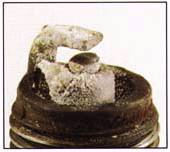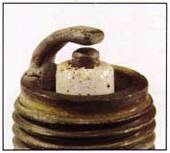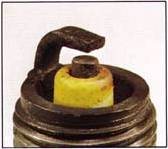|
Reading Your Spark Plugs |
The following information is provided by:
Atlantic Jet Sports Tech Talk
V-Twin Cafe' Motorcycle Performance Guide
| Reading spark plugs can be a valuable tuning aid. By examining the spark plug insulator color, you can determine valuable information about the engine's overall operating condition. | ||
Normal: Grey to Light Golden-Brown Color
|
 |
|
Dry: Black Soot Buildup
|
 |
|
Wet Fouling: Shiny, Wet, Black Appearance
|
 |
|
Excess Deposits: Bumpy, Chalky Buildup
|
 |
|
Overheated: White, Blistered, Melted Electrode
|
 |
|
Lead Fouling
|
 |
|
The definition of the spark plug's purpose is straight forward. A spark plug seals the combustion chamber. It conducts a spark that is generated in the ignition coil into the combustion chamber and provides a gap for that spark to jump across. Finally, it conducts the heat it picks up in the combustion process to the cylinder head and into the cooling system. When a spark plug provides these three basic items, it is then capable of initiating the combustion process, There is a large amount of technology which goes into the design and manufacture of a spark plug that meets these requirements and provides long life and superior engine performance. It is important to remember that there is no design that will allow a spark plug to generate more voltage or hotter spark because the spark energy is generated in the coil. It is also important to remember that spark plugs do not produce heat. They pick up heat from the combustion chamber and move it to the cooling system. This basic definition of a spark plug will benefit you as the features and designs of spark plugs are described. It will also help you to better understand the value of reading spark plug firing end conditions.
|
||
Today's spark plugs use resistors to eliminate radio frequency interference (RFI) which can affect on-board computer or ignition systems, AM and FM radio reception, and TV broadcasts. Each time the spark jumps across a gap, an electromagnetic field is created that can interfere with radio signals. By placing a resistor in the spark plug, we can substantially reduce RFI. Furthermore, the use of non-resistor plugs with today's complex computer systems can result in drivability problems, loss of performance and can even cause the computer to store trouble codes. Many motorcycles produced now have computer controlled ignition and/or fuel injection systems. RFI can effect these components. Several motorcycle aftermarket ignition modules are sensitive to RFI. Most notable among these are some modules produced by DynaTech. Use of proper spark plugs and ignition wires will eliminate the problems observed.
|
||
As discussed, a spark plug is made up of ceramics, steels and nickel alloys. These materials do not have the ability to produce energy or heat. When we talk about the heat range of a spark plug, we're referring to its ability to move heat away from its tip or core nose into the cooling system. A cold spark plug would have a cooler tip temperature than a hot one. With today's fuels, we know that anytime the tip of the ceramic core nose goes below 850 F, carbon will build up and the spark plug will foul. We also know that if the tip temperature of the plug exceeds 1550', the metals will begin to break down. At approximately 1700, the plug will glow and can become a source of pre-ignition within the combustion chamber. Armed with this information, it becomes clear that maximum performance can be achieved with a spark plug that has a temperature of greater than 850 at idle, but no more than 1550' under wide open throttle.
|
||
